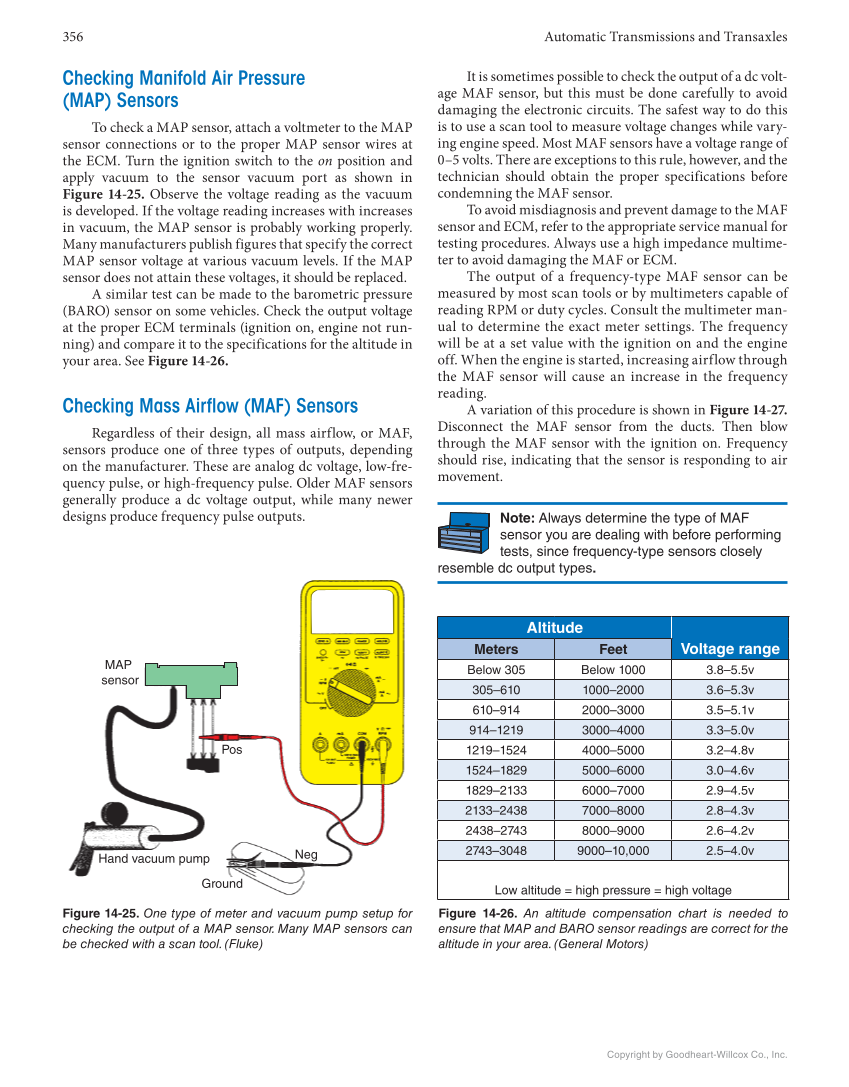356 Automatic Transmissions and Transaxles Copyright by Goodheart-Willcox Co., Inc. Figure 14-25. One type of meter and vacuum pump setup for checking the output of a MAP sensor. Many MAP sensors can be checked with a scan tool. (Fluke) Checking Manifold Air Pressure (MAP) Sensors To check a MAP sensor, attach a voltmeter to the MAP sensor connections or to the proper MAP sensor wires at the ECM. Turn the ignition switch to the on position and apply vacuum to the sensor vacuum port as shown in Figure 14-25. Observe the voltage reading as the vacuum is developed. If the voltage reading increases with increases in vacuum, the MAP sensor is probably working properly. Many manufacturers publish figures that specify the correct MAP sensor voltage at various vacuum levels. If the MAP sensor does not attain these voltages, it should be replaced. A similar test can be made to the barometric pressure (BARO) sensor on some vehicles. Check the output voltage at the proper ECM terminals (ignition on, engine not run- ning) and compare it to the specifications for the altitude in your area. See Figure 14-26. Checking Mass Airflow (MAF) Sensors Regardless of their design, all mass airflow, or MAF, sensors produce one of three types of outputs, depending on the manufacturer. These are analog dc voltage, low-fre- quency pulse, or high-frequency pulse. Older MAF sensors generally produce a dc voltage output, while many newer designs produce frequency pulse outputs. It is sometimes possible to check the output of a dc volt- age MAF sensor, but this must be done carefully to avoid damaging the electronic circuits. The safest way to do this is to use a scan tool to measure voltage changes while vary- ing engine speed. Most MAF sensors have a voltage range of 0–5 volts. There are exceptions to this rule, however, and the technician should obtain the proper specifications before condemning the MAF sensor. To avoid misdiagnosis and prevent damage to the MAF sensor and ECM, refer to the appropriate service manual for testing procedures. Always use a high impedance multime- ter to avoid damaging the MAF or ECM. The output of a frequency-type MAF sensor can be measured by most scan tools or by multimeters capable of reading RPM or duty cycles. Consult the multimeter man- ual to determine the exact meter settings. The frequency will be at a set value with the ignition on and the engine off. When the engine is started, increasing airflow through the MAF sensor will cause an increase in the frequency reading. A variation of this procedure is shown in Figure 14-27. Disconnect the MAF sensor from the ducts. Then blow through the MAF sensor with the ignition on. Frequency should rise, indicating that the sensor is responding to air movement. Note: Always determine the type of MAF sensor you are dealing with before performing tests, since frequency-type sensors closely resemble dc output types. MAP sensor Hand vacuum pump Ground Neg Pos Figure 14-26. An altitude compensation chart is needed to ensure that MAP and BARO sensor readings are correct for the altitude in your area. (General Motors) Altitude Voltage range Meters Feet Below 305 Below 1000 3.8–5.5v 305–610 1000–2000 3.6–5.3v 610–914 2000–3000 3.5–5.1v 914–1219 3000–4000 3.3–5.0v 1219–1524 4000–5000 3.2–4.8v 1524–1829 5000–6000 3.0–4.6v 1829–2133 6000–7000 2.9–4.5v 2133–2438 7000–8000 2.8–4.3v 2438–2743 8000–9000 2.6–4.2v 2743–3048 9000–10,000 2.5–4.0v Low altitude = high pressure = high voltage
